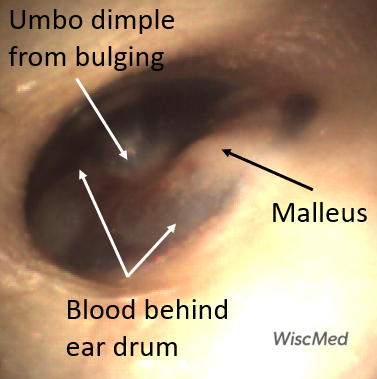
Hemotympanum – January 11, 2024
A 55-year-old female presents to the emergency department (ED) with a bloody nose (epistaxis). Her medical history is significant for chronic liver disease and past admissions requiring transfusions of platelets. She states she suffers from “daily” nose bleeds. This episode started earlier in the day and she has been using nasal packing and pressure to control it. While in the ED she states her hearing is muffled on the left side and requests a hearing test. She has no ear pain, fevers, or other infectious symptoms. She is jaundiced and ill-appearing on exam. Her HEENT assessment is notable for dried blood in the bilateral nares without active bleeding. Her WiscMed Wispr otoscope exam is shown.
What is the likely cause of the patient’s hearing complaints?
- Sensorineural hearing loss associated with chronic liver disease
- Hemotympanum causing conductive hearing loss
- Acute otitis media (AOM)
- Chronic middle ear effusions (MEE)
Answer:
B – Hemotympanum causing conductive hearing loss.

The Wispr exam demonstrates mild bulging and hemotympanum as noted by the bloody-appearing middle ear fluid. The differential diagnosis for hemotympanum includes basilar skull fracture, hemorrhagic otitis media, and ruptured hemorrhagic bullae. However, this patient has no history of injury, ear pain, or fever to support such diagnoses. She does however have chronic liver disease—a risk factor for coagulopathy due to liver dysfunction and splenic sequestration of platelets. Given her physical exam findings and known need for platelet transfusions, the latter is likely the primary factor for her challenging epistaxis history.
Hemotympanum from epistaxis occurs when blood flows retrograde from the nasopharyngeal opening of the eustachian tube (ET) into the middle ear space. While retrograde flow is typically minimized by mucociliary action and a “physiologic valve” whereby the medial portion of the ET is collapsed (ie closed) in the resting state. The opening is controlled by several accessory muscles near the soft palate that are activated by swallowing or yawning and allows equalization of pressure (“clearing the ear, valsalva”). Likewise, nasal packing combined with brisk bleeding can overcome the tube’s protective measures and result in the accumulation of blood in the middle ear space. Here is another example of retrograde hemotympanum.
Both acute otitis media and middle ear effusion are middle ear conditions resulting from inflammation.
WiscMed appreciates the contribution of Dr. James Elliott of the University of Wisconsin for identifying this interesting case.
Szymanski A, Agarwal A. Anatomy, Head and Neck, Ear Eustachian Tube. [Updated 2023 Jun 26]. In: StatPearls [Internet]. Treasure Island (FL): StatPearls Publishing; 2023 Jan-. Available from: https://www.ncbi.nlm.nih.gov/books/NBK482338/
Here is the complete video exam.








































































































































































































